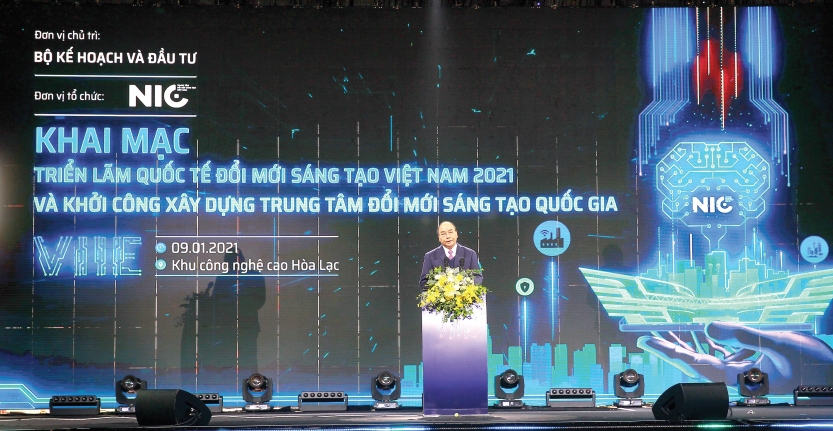Annual targets for 2021 tough but achievable
Prime Minister Nguyen Xuan Phuc addressing the opening ceremony of the first-ever Vietnam International Innovation Exhibition and the construction of the National Innovation Centre, Photo: Chi Cuong The Ministry of Planning and Investment last week held the first Vietnam International Innovation Exhibition (VIIE), and began construction of the National Innovation Centre (NIC) at Hoa Lac High-tech Park in Hanoi on January 9. The VIIE was created to connect activities among startups and small- and medium-sized enterprises with investment funds and big firms. The event also did the same between foreign and local firms. The VIIE also showcased Vietnam’s innovation achievements, contributing to raising awareness of innovation of both the public and enterprises. A wide range of products from many domestic and foreign businesses were introduced at the event, which housed 150 booths. Demonstrations of products were also carried out at the VIIE, where five specialised roundtables on different topics related to innovation also took place. Meanwhile, the $74 million NIC boasts two main sections. The 9-hectare first area is home to the centre’s headquarters. The 14-ha second section will be used for building auxiliary facilities such as homes, villas, schools, a hospital, shops, and entertainment facilities in service of those working and living here. The NIC aims to support the application of high technologies for Vietnamese enterprises, and assist the country’s research and development capacity, contributing to the implementation of the National Strategy on Industry 4.0. The NIC will connect and cooperate with innovation centres nationwide in order to create a connected system. It will also help improve Vietnam’s labour productivity and competitiveness, contributing to turning the country into a high middle-income nation. |
The Ministry of Finance reported that public investment disbursement reached 82.8 per cent of the total plan. What has been the driving force of the result?
 |
| Deputy Minister of Planning and Investment Tran Quoc Phuong |
The direction of the government related to public investment disbursement has been the most drastic ever, because it was too difficult to enable the economic growth we desired in this pandemic year. Public investment played an important role in this context, contributing to growth in two aspects – disbursement amount equalling expenditure of the government was calculated in GDP scale; and state-funded projects could offer spillover impacts and value to socioeconomic development.
Additionally, 2020 was the last year to apply the old regulations of the Law on Public Investment 2014, while a new law is now applied. In the new law if localities, ministries, and agencies cannot disburse all of the amount planned for the year, the left amount will be cut from the total budget in the mid-term plan. This is a new punishment for low-performing projects, and it is hoped this will accelerate their progress.
For example, an investor could be allocated VND5 trillion ($217.4 million) in mid-term public investment, including VND1 trillion ($43.5 million) for the first year. But if they disburse VND800 billion ($34.8 million) only in the first year, the total amount for the mid-term will be decreased by VND200 billion ($8.7 million) to VND4.8 trillion ($208.7 million).
The new law also adjusts the disbursement period to one year instead of two years as before, so all investors should build their plans in a more exact and reasonable fashion.
Thanks to the huge amount of the public investment, GDP growth in 2020 was 2.91 per cent. So what will provide growth momentum in 2021?
We cannot confirm that public investment disbursement was the only driving force of the economic growth in 2020, although the scale and speed of disbursement has been the biggest and fastest ever.
There are three key sectors for boosting GDP value – agriculture, industry, and services. So the size of GDP depends on numerous driving forces, not only one area.
However, we can see the role of public investment. Around a third of GDP value is contributed by total development investment capital, which is made 25 per cent by public investment. That means public investment can capture around 6-7 per cent of GDP only.
Of course, this is the estimation of the direct contribution of the public investment into GDP, excluding spillover effects of projects to GDP. This also reaffirms that public investment disbursement plays an important role, but is not the only factor.
The government and National Assembly (NA) have already planned $119.5 billion for mid-term public investment. Can you share more details of implementation this year and for 2021-2025 as a whole?
The portfolio of the new mid-term period of 2021-2025 will be approved by the new-tenure NA, which will be formed in the middle of the year. In the first half of 2021, investors will implement projects approved last year.
There are two types of projects for the first half of the year. Those which have yet to be developed but had already been listed in the mid-term plan for 2016-2020 will be carried out in the first half of 2021, if they received approval before December 31, 2020.
Meanwhile projects that have never been listed or proposed in any public investment plan previously will be put into the mid-term plan in 2021-2025, and await approval by the new-tenure NA to be allocated in the budget. So investors, localities, ministries, and agencies should exercise all procedures in order to start bidding, investing, and developing right after approval.
The Ministry of Planning and Investment will collect all proposals and portfolios from localities, ministries, and agencies in May to submit to the government in June, and to the NA in July.
The process means the public investment plan for the next period has yet to be built, so how can the government assess the ability to achieve growth of 6.5 per cent in 2021?
It will be quite difficult to grow that much in 2021, from 2.91 per cent in 2020, but GDP growth of the country was of course much higher at 6.8, 7.08, and 7.02 per cent before the pandemic hit. Thereby, GDP growth at 6.5 per cent in 2021 would signal a proper recovery rather than a real increase.
We do believe, however, that the target set forth is approachable thanks to the recovery signals of the three driving forces of consumption, export value, and investment. Of these, agricultural and industrial production is brighter, while some types of services are still hurting, although some other areas are developing well.
Export value is expected to increase continuously thanks to new free trade agreements, and public investment disbursement in 2021 is expected to be equivalent or higher than the result of 2020.
However, some unpredictable factors include the COVID-19 pandemic, the effectiveness of vaccines, and natural disasters. I hope that vaccines can control the pandemic outbreak and countries can then open for travel, trade, and investment, although there could be a “vaccine war” in 2021-2022.
What the stars mean:
★ Poor ★ ★ Promising ★★★ Good ★★★★ Very good ★★★★★ Exceptional
 Tag:
Tag:
Related Contents
Latest News
More News
- Ho Chi Minh City hits $8.37 billion in FDI (December 29, 2025 | 08:28)
- Tax sector wraps up 2025 and sets priorities for next year (December 25, 2025 | 14:00)
- Heavy industries set for pilot greenhouse gas quotas (December 25, 2025 | 10:00)
- $250 million deal targets women-owned SMEs, sustainable agriculture (December 22, 2025 | 17:40)
- UOB sees Vietnam growth easing in fourth quarter (December 22, 2025 | 17:39)
- Government moves to establish International Financial Centre (December 21, 2025 | 21:00)
- Vietnam's IFC to target global investment flows (December 21, 2025 | 18:00)
- Ha Tinh breaks ground on major Vingroup industrial and energy projects (December 19, 2025 | 18:24)
- EVN launches major power infrastructure projects nationwide (December 19, 2025 | 18:17)
- VAL inaugurates second production line to meet domestic animal feed demand (December 19, 2025 | 16:37)
























 Mobile Version
Mobile Version